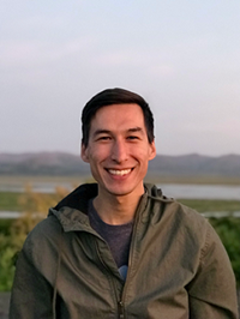Preserving Endangered Languages

Lonny Alaskuk Strunk
Software Developer, Yuarcuun Technologies
Growing up in southwestern Alaska, Lonny Alaskuk Strunk went to school in his Native Yup’ik language until fourth grade. Then instruction switched completely to English. Seeking to further connect with his heritage in college, he studied Yup’ik at the University of Alaska Fairbanks.
During his studies, he noticed Yup’ik lacked something that most other languages have — online resources that could help people learn and understand the language.
“There’s not a lot of audio, video or interactive Yup’ik resources available,” he said of a language that’s now spoken by fewer than 10,000 people. “The language data isn't accessible on the internet. It lives on people's hard drives or in print.”
Lonny, a computer science major, decided to help create more accessible digital resources for Yup’ik and other Alaska Native languages. But to do so, he felt he needed a deeper understanding of language technology. So, after graduating, he decided to pursue a master’s in computational linguistics from the University of Washington.
“I looked for programs that offered the study of computational linguistics with a focus on under-resourced and endangered languages,” he said. “I came across the UW program and saw that the faculty has done research on these types of languages. I knew they could help me pursue my goals in working with Yup’ik. Ultimately, I hope to make Yup’ik a first-class language on the internet."
Where did you grow up, and what is the state of the Native language (Yup’ik) there?
I’m originally from Kuinerraq (Quinhagak, Alaska); it’s a community of about 800 people. The state of the language depends on the generation. My grandparents spoke Yup’ik (also referred to as Yugtun) as their first language, and my mom’s generation is fully bilingual (Yup’ik and English). Growing up as a heritage speaker of Yup’ik, I understood what was said to me, but I had trouble forming my own sentences. There are some communities in Alaska that are stronger in their Native language and pass it on more consistently. Then there are some villages where people my age don’t even understand it.
Describe how your passion for your Native language led you to the UW master’s program.
I got my bachelor’s degree at the University of Alaska Fairbanks in computer science, with minors in Japanese and Yup’ik. When I first heard of natural language processing and computational linguistics, I knew I wanted to create language technology for Yup’ik — but I didn’t know enough. That’s when I began researching programs and found the CLMS program at the UW.
How did completing the UW program help you accomplish your goal?
Going through the master’s program, I realized that many applications rely on statistical methods that require a lot of language data that Yup’ik doesn’t have readily available. Looking at the language technology efforts for other endangered languages, I noticed many of the researchers were creating rule-based, finite-state morphological analyzers that only require a dictionary and a reference grammar to encode the grammatical rules.
Since Yup’ik is a polysynthetic language, where a complex word can be composed of many significant parts, I decided this was a perfect first step toward creating more language technology applications. This resulted in my thesis project: “A Finite-State Morphological Analyzer for Central Alaskan Yup’ik.”
Can you explain how that project relates to the work you’re currently doing?
I’m a software developer at Yuarcuun Technologies where I work alongside another Yup’ik software developer, Christopher Egalaaq Liu. We are currently working on web development for Alaska Native languages, such as creating interactive online dictionaries for Yup'ik and Iñupiaq. We partner with Native tribes and organizations to pursue grant-funded language technology projects that will benefit their communities.
For example, my master's thesis project is now embedded in an online dictionary, where users can analyze Yup'ik words or create their own with the word builder. My aspiration is to develop language technology for Alaska Native languages to promote the accessibility of resources to speakers and learners of these languages.
My hope is that other speakers and language programs will be able to utilize these resources to keep these languages alive. I think knowing your native language is so important in terms of understanding and accessing your cultural identity and worldview.
How will what you learned in your master’s program help you in this effort going forward?
One thing I learned in the program was to be familiar with advances in the language technology field and see where the field is going. For example, we learned a lot about statistical methods and neural methods, which is what modern artificial intelligence is using. Because of recent advances, pretty soon those methods will be applicable to Yup’ik — to be used for things like a speech synthesizer for text-to-speech applications, where learners can hear the novel words they create.
Why would you recommend this program to others who are considering getting a master’s?
This is a great program for people who want to go into industry or academia. It offers a lot of flexibility — you can complete it in one to three years, and it’s offered both in-person and online. My cohort featured a good mix of technical and nontechnical students from a variety of backgrounds. I was very thankful for that diversity because of my unique interest in Native language technology.
— Interview by David Hirning (October 2023)